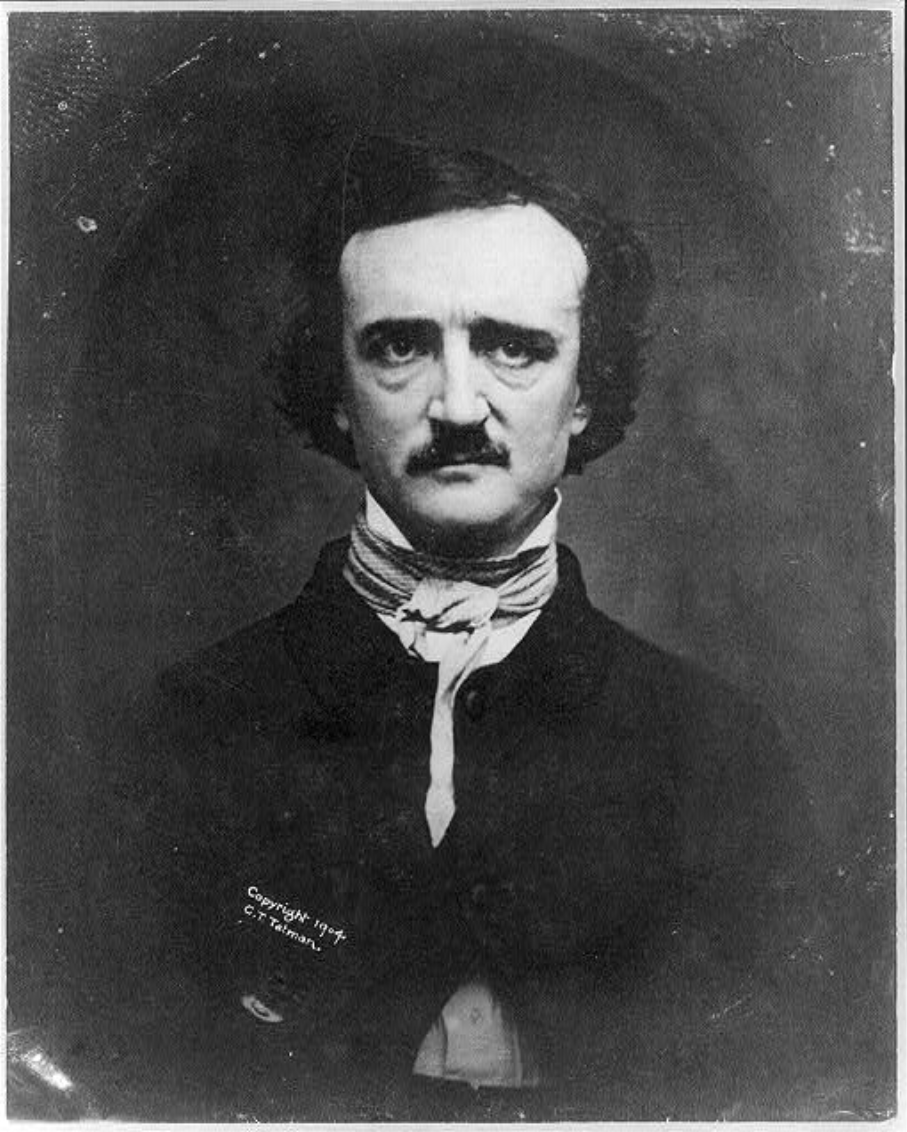Headnote for Edgar Allan Poe
By
Tonya Howe
 Source: W.S. Hartshorn, daguerrotype portrait of E. A. Poe (1848/1904)Edgar Allan Poe is an American author (1809-1847) whose life was marked by
tragedy and turbulence, but whose work left an even greater mark on literary
history. He is considered to be the founder of the detective story and the
horror genre; he wrote criticism, poetry, prose, and more, but he is perhaps
most well-known for his macabre short stories, several of which are represented
in Literature in Context. He is the first American author to earn a living by
authorship alone; his work is characterized by Gothic and Romantic themes.
Source: W.S. Hartshorn, daguerrotype portrait of E. A. Poe (1848/1904)Edgar Allan Poe is an American author (1809-1847) whose life was marked by
tragedy and turbulence, but whose work left an even greater mark on literary
history. He is considered to be the founder of the detective story and the
horror genre; he wrote criticism, poetry, prose, and more, but he is perhaps
most well-known for his macabre short stories, several of which are represented
in Literature in Context. He is the first American author to earn a living by
authorship alone; his work is characterized by Gothic and Romantic themes.
Poe was born in 1809 in Boston, to parents David and Elizabeth Poe (both actors). Just a few years later, Poe’s father left and his mother died, and the young Poe was taken in by John and Frances Allan of Richmond, Virginia, who became his legal guardians. After attending school in England, he returned to the US in 1820; plagued by financial problems that also followed John Allan, Poe began studying at the University of Virginia in 1826, but after running up gambling debts, he was forced to withdraw--after less than a year in residence. He was frequently in conflict with John Allan over financial and career matters, and in 1827, Poe left the Allans for Boston, where he began to publish and enlisted in the Army. When his foster mother Frances died in 1829, he returned to Virginia in part to seek a reconciliation with John. He was discharged from the Army and moved in with his aunt, Maria Clemm, in Baltimore, Maryland, where he tried to launch his literary career.
John Allan secured Poe an appointment to West Point, but the young author, who had different ideas, was court-martialed for disobedience and neglect of orders. Finding himself living once again with Maria Clemm in Baltimore, Poe continued to publish in and work for various magazines. He attempted a death-bed reconciliation with his foster father, to no avail, and by the mid 1830s, Poe’s literary career was beginning to grow—both because of his own literary creations and because of his work as a reviewer; he gained a reputation for vicious, excoriating reviews of other authors, and his professional life was marked by conflict.
He married his cousin, Virginia Clemm, in 1836, moving to Philadelphia, and then to New York. His Tales of the Grotesque and Arabesque was published in 1839, containing many of the short stories previously appearing in magazines. The 1840s were characterized by periods of intense literary production, drinking, and failed attempts to gain employment, leading to intermittent destitution. Two more collections--Tales by Edgar A. Poe and The Raven and Other Poems—were both published in 1845, and Virginia, who had dealt with tuberculosis for some time, died in 1847, in their cottage in Fordham, New York, where they had moved in 1846.
For the last two years of his life, Poe continued to write, give lectures, seek to found his journal, drink, court potential wives, and drink some more. He moved back to Richmond in 1849, but on the third of October, he was found, semi-conscious, in Baltimore and died there soon after. He remains a celebrity claimed by Philadelphians, Virginians, and Marylanders alike, his life and work celebrated by the mysterious “Poe Toaster” annually on his birthday from sometime in the 1930s to the early 2000s. Many new readers of Poe interpret his tales as reflections of his personal biography; however, it would be a mistake to read his works solely through this lens.
Though Poe achieved literary acclaim during his lifetime, his reputation was largely negative, especially by his Anglo-American readers, who were heavily influenced by the role of biography in literary appreciation. His tales were colored by a misanthropic personal reputation cemented by contemporary critics, and readers felt he—and his works—were not morally fulfilling, as literature ought to be (biographer Kevin Hayes notes that Poe’s verse was more accepted than his tales for this reason). But in Europe, his reputation was quite different--the French poet Charles Baudelaire, who saw Poe as something of a kindred spirit, wrote a significant critical biographical essay in 1852, and many other European authors and artists drew inspiration from him—Mallarme, Manet, Gaugin, the Surrealists Dali and Magritte, and even early filmmakers found in Poe’s tales a rich psychological depth and imaginative intensity to be inspired by. Poe’s imagery and narrative exerted a profound on twentieth-century literature and art, and it continues to be felt today.
For more information about Poe’s life, see biographies by Jeffrey Meyers and Kevin Hayes. The Poe Encyclopedia is also a useful source for general information. Readers interested in Poe’s own perspective on his work and literature more broadly should examine his criticism, especially “The Philosophy of Composition.”